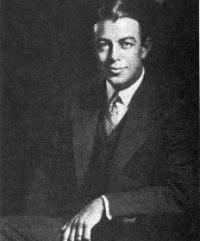Benjamin Lee Whorf: Difference between revisions
No edit summary |
No edit summary |
||
| Line 1: | Line 1: | ||
[[File:B.L.Whorf.jpeg|right|200px|thumb|Benjamin Lee Whorf]]<br> | [[File:B.L.Whorf.jpeg|right|200px|thumb|Benjamin Lee Whorf]]<br> | ||
'''Benjamin Lee Whorf''' (April 24, 1897 – July 26, 1941) was an American fire prevention engineer who worked in the insurance industry. As an avocation, he studied linguistics. Whorf is widely known as an advocate for the idea that because of linguistic differences in grammar and usage, speakers of different languages conceptualize and experience the world differently. This principle has frequently been called the "Sapir–Whorf hypothesis", after him and his mentor Edward Sapir, but Whorf called it the principle of linguistic relativity, because he saw the idea as having implications similar to Einstein's principle of physical relativity. | '''Benjamin Lee Whorf''' ([[April 24]], 1897 – July 26, 1941) was an American fire prevention engineer who worked in the insurance industry. As an avocation, he studied linguistics. Whorf is widely known as an advocate for the idea that because of linguistic differences in grammar and usage, speakers of different languages conceptualize and experience the world differently. This principle has frequently been called the "Sapir–Whorf hypothesis", after him and his mentor Edward Sapir, but Whorf called it the principle of linguistic relativity, because he saw the idea as having implications similar to Einstein's principle of physical relativity. | ||
He became a member of the [[Theosophical Society in America]] on February 2, 1940, joining the Hartford, Connecticut Lodge. Mr. Whorf's son Ray also joined the TSA at the Ojai Valley Lodge on September 2, 1940. Ray married Torre Perkins, the daughter of [[James S. Perkins]], who served as TSA President from 1945-1960. | He became a member of the [[Theosophical Society in America]] on February 2, 1940, joining the Hartford, Connecticut Lodge. Mrs. Whorf was also active in the Hartford Lodge and in the Northeast Federation. After her husband died on [[July 26]], 1941, she hosted a reception for the federation at her home with a vegetarian supper, musical entertainment, and a talk by [[Fritz Kunz]].<ref>"The Northeast Federation," ''The American Theosophist'' 30.5 (May, 1942), 115.</ref> | ||
Mr. Whorf's son Ray also joined the TSA at the Ojai Valley Lodge on September 2, 1940. Ray married Torre Perkins, the daughter of [[James S. Perkins]], who served as TSA President from 1945-1960. | |||
==Online resources== | ==Online resources== | ||
Revision as of 15:46, 4 February 2016

Benjamin Lee Whorf (April 24, 1897 – July 26, 1941) was an American fire prevention engineer who worked in the insurance industry. As an avocation, he studied linguistics. Whorf is widely known as an advocate for the idea that because of linguistic differences in grammar and usage, speakers of different languages conceptualize and experience the world differently. This principle has frequently been called the "Sapir–Whorf hypothesis", after him and his mentor Edward Sapir, but Whorf called it the principle of linguistic relativity, because he saw the idea as having implications similar to Einstein's principle of physical relativity.
He became a member of the Theosophical Society in America on February 2, 1940, joining the Hartford, Connecticut Lodge. Mrs. Whorf was also active in the Hartford Lodge and in the Northeast Federation. After her husband died on July 26, 1941, she hosted a reception for the federation at her home with a vegetarian supper, musical entertainment, and a talk by Fritz Kunz.[1]
Mr. Whorf's son Ray also joined the TSA at the Ojai Valley Lodge on September 2, 1940. Ray married Torre Perkins, the daughter of James S. Perkins, who served as TSA President from 1945-1960.
Online resources
Articles
- A Notable Theosophist: Benjamin Lee Whorf by John Algeo
- The Mind of Benjamin Whorf by David Lavery
- Language, Mind and Reality by Benjamin L. Whorf
Further reading
- Carroll, John B. (ed.) Language, Thought, and Reality: Selected Writings of Benjamin Lee Whorf (Cambridge, Mass.: Technology Press of Massachusetts Institute of Technology, 1956) x, 278 pp.
Notes
- ↑ "The Northeast Federation," The American Theosophist 30.5 (May, 1942), 115.